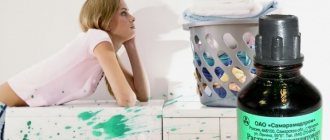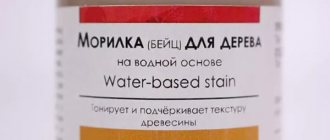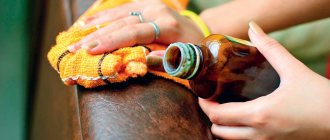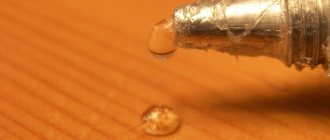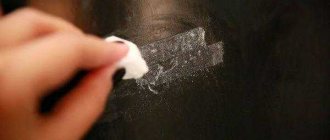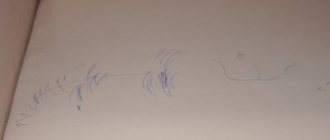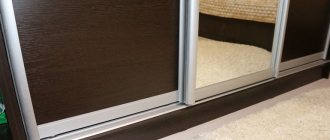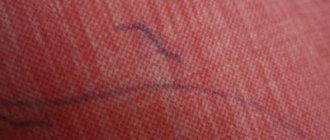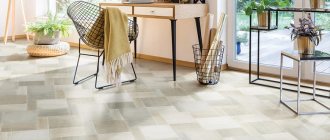Stain is an excellent wood treatment product. It can breathe new life into old frames, refine furniture, and protect things made from wood from rot. But its significant drawback is the ability to tightly stick to surfaces, eating deeply into them. Let's figure out how to wash stain from your hands, remove stains of this product from clothes, and remove from the floor and furniture.
How to remove old varnish from furniture at home.
Each of us dreams of home comfort and coziness, of a beautiful interior. Sometimes you want to radically change everything, change the situation.
Today lacquered furniture is very popular.
It’s a pity to throw away some items; they are still quite strong, but look unsightly due to the shabby varnish. Nowadays, you can restore furniture and remove varnish at home. And it will serve you for many years to come.
Such products look beautiful and add solidity to the interior.
If you think that there is a super nail polish remover, then such an opinion is wrong. In its production there is never one base, it is always different. Consequently, many solvents are made.
You need to choose the product carefully to remove the varnish and not damage the furniture.
Before embarking on such a responsible task, you should prepare thoroughly. Select a coating removal method, prepare the necessary materials and tools.
First of all, you will need protective equipment - special glasses, gloves, a respirator.
And to remove varnish - a remover, a brush to apply the product, a spatula, sanding tape, a sanding machine, a hair dryer, and also plastic film.
The process is not easy. The varnish cannot be removed in one go.
In this matter, different methods are used. When selecting them, the following points are taken into account.
- Type of base. It all depends on what you will be processing - flooring or furniture.
- View of the previous coating. When choosing a method, you should focus on the composition of the varnish, because they are different in composition.
- Number of layers. With a multi-layer coating, maximum time and effort is required, while removing a thin layer will not be difficult.
Information on how to remove varnish from wood can save many pieces of old furniture from vegetating in landfills.
Comments
see also
I'm smart - I sloppily painted the countertop under the sink, thinking that I could easily wipe off the sink itself and the tiles. Nail polish remover helped, but wasn't great. Besides, it's over. The solvent does not take at all, although...
Please advise! The apartment was renovated for four years (in parts). At the very beginning, a new metal door was installed; when purchased, it was covered with a self-adhesive film; of course, they did not remove it. Once the renovation was completed, I began...
Girls, DD. There are chairs made of white leatherette that my son painted with a ballpoint pen. I rubbed everything that was at hand, but the stains were ingrained and did not budge. What other remedy should I try? Soaped with formic alcohol, nail polish remover...
Girls, please advise how I can wipe off the paint if white spirit doesn’t work? The pants are black, the paint is white and very visible. The border paint (my son brought it after a walk on a scooter, and has long since dried (while we bought the solvent, it has almost grown in...
Yesterday an installer came and installed an interior door and accidentally splashed foam, but it doesn’t wipe off the laminated surfaces at all. So, we tell him, wipe off this stain, it’s in the middle of the door and all this...
Girls, help...they are painting benches everywhere now...we painted them green...and they already took off the paper (which had been painted since it had been there for several days, apparently they painted it with cheap, bad paint...if it dries like that), and Sonya plopped down in new blue jeans ..how to wipe off this miracle((...varnish for...
1. Does anyone have any positive experience in assembling an IKEA kitchen on their own?? Is this real? My husband is planning to pack his uncle together, I’m trying to dissuade him, but so far it’s in vain) 2. Owners of acrylic countertops with cast sinks - I read here yesterday...
Kitchen. In the kitchen, everything is always at hand, well, this is understandable, in a 6-meter kitchen, no matter how you turn, everything is still at hand))), I laugh... Well, there’s no escape, what is what is….
How can you really remove masking tape from glass? Before painting the windows I glued it, in short it stuck to the glass like this…. I’ll say right away, Google didn’t help, maybe there is a product that dissolves it... I don’t know 1) I tried white spirit and some kind of solvent, it didn’t help...
In private houses, country houses, and often in apartments, wooden products are used, such as doors, windows, flooring, gazebos, furniture and decorative parts. And no matter how magnificent wood is in its original form, due to the constant influence of external factors and time, it gradually loses its consumer qualities and attractiveness. What to do in such a situation? The answer is very simple: if you want to preserve the natural structure and appearance of wood for many years, stain will help you.
Stain is not paint; it will not hide the texture of the wood (you can see this in the photo)
Several methods for removing varnish from furniture
For example, delicate. If you need to clean the surface of very old furniture or a varnished surface, coating with a remover would be the most acceptable option.
The most relevant method is to treat the coating with a chemical composition, the so-called stripper.
These can be liquids, acetone as a widely used product, gels, or any powders. It is best to treat shellac surfaces with denatured alcohol.
It is more convenient to use a remover in powder form.
It is diluted with water and the resulting paste is applied to the coating. The product should work within the time specified in the instructions. It is preferable to hold objects vertically; cleansing will be better, and special gels can remove even deep layers. Ready-made liquids will remove only a few layers.
The old varnish is removed with a non-sharp spatula, preferably a plastic one, in the direction of the grain.
Paint stains
A mixture of baking soda and vinegar removes such marks well. You can also use baking soda mixed with lemon juice. The mixture is applied with a finger or a sponge to the stain, rubbed well, then the area is polished. Good results are obtained by using a regular school eraser, which will cope with paint stains on lacquered furniture. If the stain is large or the paint layer is thick, you can first carefully remove it with a spatula, being careful not to damage the wood or leave scratches.
To remove such contaminants from a wooden surface, you can use ammonia diluted in water. Or drying oil, or regular talc.
Coating removal process: step-by-step instructions
You can consider the process of cleansing with a remover step by step. Before starting work, we remove the drawers from the furniture, remove the doors, and lay a lot of newspapers on the floor.
The main thing is not to damage the wooden covering itself, otherwise you will ruin the entire restoration process.
We wear protective equipment, otherwise you will receive serious burns. You will need a regular brush. First of all, we cover the surface with wash in one layer, brushing only in one direction.
We proceed from the rule that the brush should be passed over one place only once, without repetition.
To get the best result, cover the top with polyethylene. We keep it on for several hours - it all depends on the number of layers. With highly effective cleaning, the remover will turn dark brown and the varnish will swell.
The average waiting time for the effect of a compress is from 1 to 4 hours, depending on how many layers are to be removed.
If the work is done correctly, it will easily come off the surface. After removing the film, remove the softened varnish with a spatula. If it doesn't go away the first time, you need to repeat it again.
It happens that sandpaper can easily remove what is left.
Then you need to remove the remaining product. Take water (about half a liter) with vinegar dissolved in it (100 ml) and a sponge, thoroughly rinse the surface and wipe with a rag. We leave the treated furniture to dry.
You need to make sure that the sun's rays do not fall on it.
The next method is mechanical. It is called looping and has a significant negative side. This takes a long time, and requires maximum effort.
In other words, this is stripping off the varnish layer using a construction tool.
It is carried out with a special-purpose tool - a cycle.
You can purchase a cycle or make it yourself.
If the layer is not thick enough, you can limit yourself to an 80-100 grit sanding belt attached to a sanding machine. After processing, take a tape with a grain size of 150 and higher and go through it again.
This method is suitable if you will be applying some other products in the future.
The additional method is thermal. To do this you will need a hair dryer. It is capable of heating the plane to a very high temperature - 600 degrees. He has the advantage of being quite fast. Heat the surface and immediately scrape it off with a spatula. But here it is necessary to observe all safety measures to avoid fire.
When working, you need to open all windows and wear hand and face protection.
To remove varnish, a water cleaning method is also used, which is the most primitive and harmless. Moisten the surface with a generously moistened sponge.
In most cases, you can clean the varnish yourself.
After some time, the varnish begins to dissolve. The wet surface is treated several times with coarse sandpaper until the coating turns into mush. The furniture is washed and dried well.
The methods are different, the work should be carried out scrupulously and carefully. The most important thing is not to spoil the tree.
Furniture prepared for restoration can be varnished again. It will not only renew, but also help preserve it from external negative influences.
By following all these rules, you will receive a high-quality lacquered furniture surface that will again acquire its original aesthetic appearance.
Nowadays, such pieces of furniture are becoming increasingly popular. Treated with varnish, it looks most advantageous and is completely harmless.
This is important in interior design.
It is worth noting that it makes no sense to remove varnish from objects made of chipboard, since the main film will come off along with the cleaning agent, which will negatively affect the appearance of the product.
Natural wood is perfectly cleaned.
In conclusion, I would like to give some useful tips.
- If the surface is covered with shellac, then a good result is obtained with the help of denatured alcohol, and it does not take much time.
- Where there are several layers, liquid products are suitable. Due to the fact that they evaporate quickly, they cannot penetrate deep into the surface.
- If the scale of work is significant, it is better to use powders due to their long shelf life.
- To remove multi-layer coating, pastes and gels are better suited.
Denatured alcohol for removing varnish from a wooden surface.
Of course, most of us buy new furniture, thereby wanting to show how we need to keep up with the times, that they have wonderful modern furnishings and a chic interior. Individual people demonstrate their material well-being in this way.
Modern furniture is not always of better quality than old furniture. And that one is many times superior in its performance to the new one.
Most simply cannot afford to purchase modern cabinets, walls, sofas, armchairs, tables, etc. Therefore, it is important to treat that furniture with care. And there are reasons for this. Without a doubt, the stores have a wide variety of products. But they only vaguely resemble wood. Natural wood is now difficult to find, and the price will be high.
Anyone who has old furniture in their home should try to restore it and preserve it for many years.
Updating furniture at home is not as difficult a process as it might seem. Your desire, a little patience, and the furniture will sparkle with new colors, giving you and your loved ones a lot of pleasure. Plus, how great it is to create with your own hands!
Useful tips
There are several tips that will help make the process of cleaning your hands from stain even safer. Pay attention to them:
- When using chemicals and various types of solvents, be sure to go outdoors.
- If you have a tendency to allergic reactions that appear on the skin of your hands, avoid using chemical compounds for cleaning.
- After washing the stain, always remove any residual solvents from your hands immediately to avoid the appearance of erosions on the skin.
- Be safe when using flammable solvents to clean your hands.
- If gentle cleaning methods are ineffective, do not immediately use aggressive ones, this will inevitably lead to chemical burns.
Remember that you should not wait for the coloring agent to penetrate deep into the layers of the skin.
What is stain
What is wood stain? It is a liquid with a special composition that can preserve wood, protect it, and give it the required color (tinting) if necessary.
Interesting! Typically, stain comes in colors that can effectively imitate fine wood. But, if your interior requires multi-colored tinting, this is also possible.
A significant difference between stain and enamels and paints is its deep penetration into the structure of the wood and coloring “from the inside.” This way the wood retains its natural grain pattern and texture. Also, an opaque layer (film) does not form on the surface of the product, as in the case of treatment with paints and varnishes.
In addition to aesthetic functions that give wood an attractive and noble appearance, stain is designed to perform such practical tasks as protecting wood from:
- Humid environment.
- Solar exposure.
- Reproduction of fungi and bacteria.
By using such a product, you can extend the life of a wooden surface tens of times.
You may not find the colors you want; you will have to select a shade by diluting the product
There are several types of stains, differing in their base. You need to choose the one that is most suitable in your case, based on the deadlines you face and what results you expect. Naturally, each type has its own pros and cons, which is why it is necessary to consider this issue in more detail.
Water based stain
This stain is sold in special stores in a ready-to-use composition or in powder form. Do-it-yourself powder stain for wood is diluted with warm water, immediately before treatment. The intensity of the coating will ultimately depend on the proportions of water and powder.
Important! After you mix the powder with water, be sure to strain the liquid to avoid getting any undissolved dye particles onto the wood!
In addition, using such a composition, you will not have a question about how to remove stain from a wooden surface. Well, if this question does arise, then the excess composition can simply be washed off with water, absorbed with a cloth or a cotton swab.
One of the advantages of water stain is the absence of a sharp specific odor. Therefore, it is often used for indoor work; also, such a mixture perfectly tints wood, emphasizing the natural pattern.
Stir until the ingredients come together
Note! This composition dries within twelve hours, during which time the painted product should not be touched or moved to a room with a different temperature and humidity.
If we talk about the disadvantages of such tinting, we can highlight its effect on the wood fibers. It raises them, which is why, after the wood dries, the surface may turn out to be rough and poorly protected from a humid environment.
However, this can be fixed in two ways:
- After the composition has dried, sand the surface.
- Moisten the surface with water and let it lift the fibers, and after drying, apply stain to the wood.
So, the main advantages of water-based stain:
- Easy to remove with water.
- Safety.
- Large selection of palettes.
The main disadvantages include:
- Raising wood fibers.
- The need to subsequently coat the wood with varnish for painting to prevent the appearance of cracks.
Alcohol based stain
The name itself suggests that this stain is based on alcohol (denatured alcohol) or a special solvent.
Just like a water-based product, it is available in the form of a finished composition or in powder form, which you will have to dissolve yourself. The price of an alcohol-based stain will be higher than a water-based one.
Using a small brush you can highlight the outline on wooden products
The coloring agents of alcohol-based stains are very quickly absorbed into the surface of the wood, and the alcohol (solvent) evaporates almost instantly. Thanks to this, drying time is reduced to 20 minutes. On the one hand this is an advantage, but on the other hand it is a disadvantage. This minus will come up when you think about how to remove stain from wood.
Simple and clear application instructions will help you avoid making mistakes:
- The solution must be applied quickly.
- Try to distribute it evenly over the surface.
- Use a spray bottle for application.
The main advantages of alcohol-based products:
- Fast drying.
- Resistant to sunlight.
- Moisture resistant.
- Pungent, unpleasant odor.
- Difficult to apply (potential for stains).
Oil based stain
In such a solution, coloring substances are dissolved in oils (most often flax oil is used as a basis).
Interesting! This type of stain is considered the most environmentally friendly, because it is not capable of emitting harmful substances, which is why it is even used in processing furniture parts for kitchens and children's rooms.
This is the most popular type of tinting among furniture manufacturers:
- Dries within two to three hours
- Absorbs deeply into the surface of the wood.
- It is unable to lift wood fibers, which is why it reliably protects against moisture.
- The treated surface does not fade at all for decades.
How to make oil-based wood stain? It’s not at all difficult, just dilute the special powder with oil. However, it is best to buy this type of stain ready-made.
And no matter how the question arises about how to remove stain from wood, it is best to immediately purchase a special solution for these purposes.
The main advantages of oil stain:
- Does not fade for many years.
- Reliably protects the surface from temperature influences and moisture.
Apply the stain using smooth movements back and forth along the texture.
Wax based stain
The latest technology in the wood processing market is a wax-based product. This substance looks like a soft paste-like mass. Tinting with such a solution will not provide deep penetration into the wood structure, but will remain on the surface in the form of a protective layer.
Attention! Wood wax stain should never be used as a base for two-component varnishes.
The wax composition is easily rubbed into the surface with a soft cloth; of course, the consumption of stain per 1 m2 of wood will be large, but it is worth it. Unless, of course, the product being processed is not used 24 hours a day.
You are unlikely to find a wax version in a regular hardware store.
How to remove stain from wood if its base is wax? Simply remove using a cloth or rubber spatula.
Wood stain, its properties and why it sticks to your hands
Stain is a wood preservative. Its main task is to preserve the material from rot, moisture penetration, fungal formation and premature destruction.
This product can firmly stick to any surface, including the skin of your hands, and to get rid of the composition you will have to make a lot of effort. If cleaning is not done immediately, the liquid will penetrate deep into the epidermis. Then it will be possible to remove it completely only after a month and a half.
If, nevertheless, it was not possible to quickly remove the stain from your hands, you need to start cleaning, but before using various products, check the composition on the basis of which they are made. These could be options:
On a note! Any solvents that are used to remove stain from hands must be combined with a gentle product: for example, a moisturizer or healing ointment. Otherwise, skin dehydration may occur.
How to remove varnish from a wooden surface?
Often, before painting or re-varnishing a wooden surface, it is necessary to remove the old layer of varnish. There are several ways to do this: wood varnish remover, mechanical method, heat treatment. Choosing a specific option often causes certain difficulties, since a person without skills is rarely able to decide on his own. The result of this is damage to the processed material.
Below we will talk about the main methods of removing nail polish, as well as the advantages and disadvantages of certain approaches.
Coffee stain
A mixture of ammonia and glycine will help to cope with this problem. Rub the solution onto a wooden floor or table; after half an hour, the mixture can be removed with a rag.
Such stubborn stains or stains from deeply absorbed water are the most difficult to remove from wood. Can be used:
- household bleach;
- hydrogen peroxide;
- a mixture of water and oxalic acid;
- a mixture of salt and burdock oil. The oil will soften the wood, and the salt will absorb all the excess.
In addition, ink stains on wood are removed with a water-soda solution; marker stains are removed with toothpaste or isopropyl alcohol. If a stain on a wooden floor is caused by a pet, you will have to use antibacterial agents, such as alcohol, to remove the unpleasant odor, and then deal with the stain itself.
In particularly difficult cases, when home remedies do not help, you will have to remove the top layer of wood, for example, with fine sandpaper or using a grinder, and then re-open it with varnish, oil or stain.
Nail polish removal methods
It must be said right away that only the most popular surface cleaning methods are covered here. There is no universal recipe that is applicable in all situations.
The choice of method depends on many variables, including:
- The type of base is of considerable importance, since it makes a difference what exactly needs to be cleaned - furniture or parquet.
- Varnish composition. Different options are relevant for different compositions.
- Layer thickness. It's one thing to remove one layer, quite another to remove many old layers.
Treatment with chemical compounds
Treating wooden surfaces with chemicals (also called stripping) is one of the most popular methods of removing varnish when it comes to delicate surfaces of furniture or other delicate objects. The chemical compositions can be powders, gels, specialized liquids or a regular solvent.
The choice of a specific option depends on the task at hand. When it comes to shellac, denatured alcohol is best. Liquids are most applicable to surfaces where there are not many layers - up to three. The fact is that the liquid tends to erode quickly, which is why it is simply not able to absorb deeply enough. Powder chemistry is the best choice for large-scale work, since such materials can be preserved for a long time. But gels and paste-like materials are best suited for removing a significant number of layers of varnish or paint.
Denatured alcohol is best for removing shellac.
Recommendation: powders are created in this consistency for ease of storage and transportation. They should be used diluted with water to form a thick paste-like mass.
It is best to apply the mixture in a vertical position. This is not only more correct from a technological point of view, but also more convenient. Gels and pastes can remove up to a dozen layers of old coating at a time.
Preventing stains
It is easier to prevent the appearance of a stain than to later try to wash off the stain from various coatings with unclear results, risking ruining them forever. Therefore, before starting work, carefully consider your protection strategy:
Always close the lid of the stain container tightly when taking breaks from working. Analysis of reviews on thematic forums shows that most problems are a consequence of an open can being knocked over due to negligence.
While working, do not throw the brush anywhere, but place it on a prepared tray from which it will not fall out onto the table. And keep a rag handy to wipe off any excess drips from your brush, jar, and workpiece before they hit the floor.
Instructions for removing varnish from a wooden surface
The entire coating removal process consists of four stages.
First stage: applying wash
We wet the brushes in the chemical composition and apply a decent layer to the surface. We proceed from the rule that the brush should be passed over one place only once, without repetition.
Second stage: film
To enhance the washing effect, we organize a compress, for which we cover the surface to be treated with a polyethylene film. The average waiting time for the effect of a compress is from 1 to 4 hours, depending on how many layers are to be removed. A good sign is if the remover changes color and becomes dark brown or brownish, and the varnish begins to swell.
Third stage: removing varnish
After the varnish has become softer, it must be removed with a spatula. The edges of the new spatula are too sharp. Therefore, it is recommended to round them slightly using a sharpening stone. This will make working with wood more accurate.
The pressure on the swollen material must be careful. You probably won't be able to completely get rid of the varnish in one go. Then you need to repeat the operation again. However, it happens that one pass with sandpaper is enough to remove the remaining varnish film.
Fourth stage: neutralization of the chemical composition
Do not forget that the chemical composition remaining on the wooden surface must be washed off either with plain water or with vinegar solution (500 grams of water per 100 ml of vinegar). You need to wash off the remaining chemicals thoroughly, but not for too long, since moisture is harmful to wood, and the surface being treated at this time is deprived of protection. As soon as the washing is completed, the surface should be wiped well, and then the item should be moved to a dry and ventilated place. Moreover, direct rays of the Sun should be avoided. After drying, the wooden product can be re-varnished.
The chemical composition remaining on the wooden surface can be washed off with plain water or vinegar solution
In addition to liquids, spray cans are also used. As a result of spraying the spray, a foam layer appears on the surface being treated. Sprays are easy to use, however, their disadvantage is the ability to wash off only minor layers.
Important! Work with chemical compounds must be carried out in compliance with safety rules. The room must be well ventilated. For protection you need to use special gloves and respirators.
Acetone is also used as a solvent. First of all, a fabric compress is made, thoroughly soaked in acetone. Then the compress is applied to the areas intended for cleaning. Cover the compress with plastic wrap and wait 10-15 minutes.
Note! Removing the varnish layer on furniture or chipboard panels can damage the surfaces, as the decorative film can be damaged. The best material for removing varnish is natural wood.
How to wash linoleum
After working with stain, stains may remain on the floor. And if it is covered with linoleum, then the pollution is very noticeable. Therefore, it is imperative to resolve the issue as soon as possible, since the liquid composition tends to be quickly absorbed and then the question of how to remove stain from linoleum will have to be resolved in more radical ways.
Using bleach or stain remover
Bleach, oxygen stain remover, peroxide, ammonia and other compounds that can discolor the surface work well with liquid stain on linoleum.
Take, for example, an oxygen stain remover that does not contain chlorine. Pour two or three measuring spoons into a plastic or ceramic container (it is not recommended to use enamel or aluminum, as the product tends to oxidize the walls of the container). Pour in a small amount of warm water and stir until a paste forms. The product should heat up and stand for 15 minutes.
Once the time is up, simply apply the prepared chemical reagent to the stain stain on the linoleum and leave for 10 minutes. You can rub the area with a sponge several times during this period to help the stain remover remove the stain. If these are liquid bleaches, then apply them to a regular or microfiber cloth and place it on the stain. Leave for 10 minutes, then rinse the floor with water.
Salt plus vinegar
The resulting stain from stain on the surface of linoleum can be removed with salt and vinegar. Perform cleaning as follows:
Afterwards, treat the area that had the stain with a regular floor cloth soaked in clean water. After this manipulation, a strong smell of vinegar may remain, so to eliminate it, simply wash the floor with a special product (for example, Mr. Muskul) and ventilate the room.
Important! Use chlorine-containing substances to remove stains on linoleum with caution. It is advisable to first experiment in an area that will not be visible during operation. Chlorine has the property of not only washing away stains from stain on different bases, but also discoloring the paint of the linoleum itself (it is used to make a pattern or ornament on the material).
If unsuccessful cleaning attempts spoil the floor covering, then you will probably have to re-lay the affected area of linoleum.
Mechanical cleaning
The essence of the technique is surface scraping. In other words, this is stripping off the varnish layer using a construction tool - a tsikli, which is a sharpened steel plate with a handle. Moreover, the handle is at an angle to increase pressure on the surface. You can purchase a cycle or make it yourself.
You can remove varnish from a wooden surface using a scraper.
You can do without a special tool by using glass. But this device has a drawback - it quickly becomes dull. If you choose glass, you need to remember to use protective gloves to avoid getting hurt.
If the varnish layer is thin, you can use regular sandpaper. Moreover, it can be used either manually or by attaching sandpaper to an angle grinder. There are three types of grinding machines:
Vibrating machines are the most affordable. This tool can be used to clean furniture.
The working process is as follows: sandpaper is installed on the “sole”, which is used to process the surface. This method of removing varnish is very dusty, but compared to manual processing, this option will give a much more aesthetic surface.
Advice! Don't forget to protect your surroundings from dust. Plastic film will do for this.
The main advantage of mechanical processing compared to chemicals is that toxic and unpleasant-smelling substances are not used. In addition, if you work carefully, this method of cleaning is more gentle on the wood than in the case of chemical compounds. Mechanics have one drawback - the process is long and labor-intensive.
The main disadvantage of mechanical processing is that the process takes a lot of time and effort.
Advice! Since mechanical cleaning takes a lot of time and also requires accuracy, it may be more rational to use the services of a hired specialist. In addition, the specialist is equipped with professional equipment, which will improve the quality of work.
Video description
How and with what to quickly wash paint, enamel, and primer from your hands.
After such a procedure, it is recommended to avoid contact of the skin with alkalis and acids for some time. Hands need to recover after such aggressive treatment.
Using soda and cola to clean the skin of hands from stain Source fotostrana.ru
Heat treatment
The essence of this process is to heat the wooden surface, due to which the varnish adheres less firmly to the surface. In other words, the varnish begins to crack, after which it can be pryed off with a tool (a chisel or spatula will do) and slowly removed.
Please pay attention to the following nuances:
- During work, you need to use protective equipment (gloves and goggles), and also ventilate the room. The fact is that when heated, the varnish releases toxic substances, and when the material is mechanically separated, pieces can bounce off of it. Also, do not forget about fire safety.
- If the varnish is heated up, but does not peel off, but becomes charred, you need to change the cleaning method and you cannot do without chemicals.
- Gasoline or gas burner. Such devices are quite inexpensive. However, the burner must be used with extreme caution, as the work will be carried out with an open flame.
Care must be taken when working with the burner
- Construction hairdryer. The device is similar to a household hair dryer, but has significantly greater temperature capabilities, heating up to 600 degrees.
Note! A standard household hair dryer is not suitable for removing nail polish.
The main advantage of the thermal method is its high speed. However, we must not forget about the danger of overheating the varnished surface, since in this case it may catch fire.
The work is done with both hands: one holds the hairdryer, which heats the surface, and the second holds a spatula for removing nail polish.
Preventing stains
It is easier to prevent the appearance of a stain than to later try to wash off the stain from various coatings with unclear results, risking ruining them forever. Therefore, before starting work, carefully consider your protection strategy:
Always close the lid of the stain container tightly when taking breaks from working. Analysis of reviews on thematic forums shows that most problems are a consequence of an open can being knocked over due to negligence.
While working, do not throw the brush anywhere, but place it on a prepared tray from which it will not fall out onto the table. And keep a rag handy to wipe off any excess drips from your brush, jar, and workpiece before they hit the floor.
